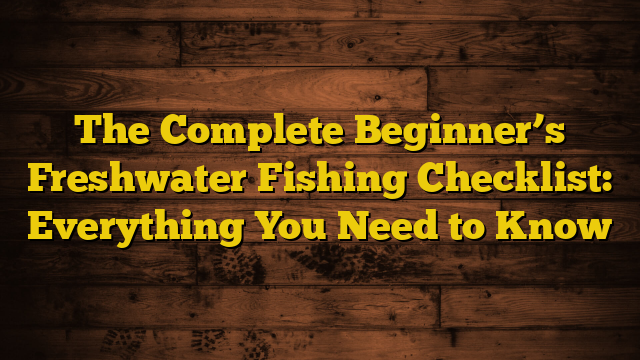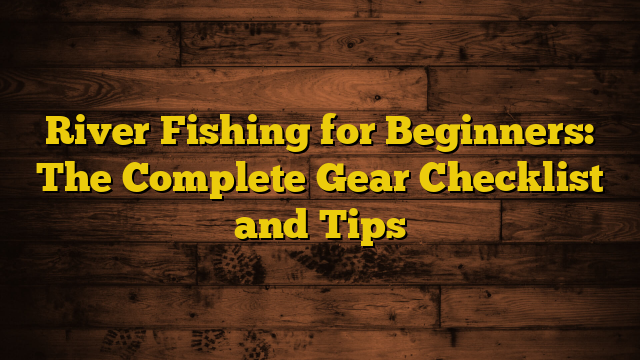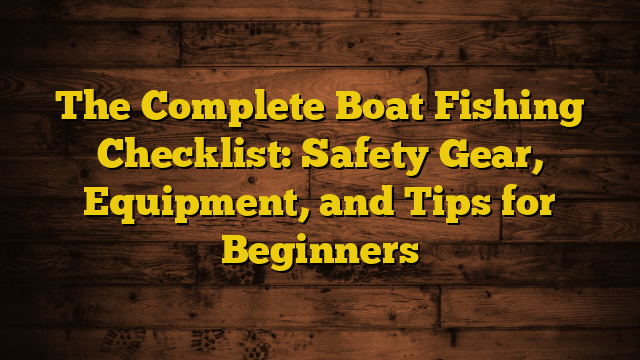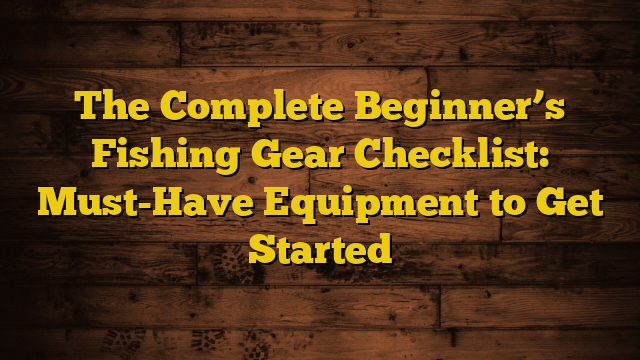Eager to start freshwater fishing but don’t know where to begin? This detailed checklist will provide you with all the gear, tackle, tips, and techniques needed for a successful day on the lake, river, or stream as a first-timer.
Freshwater fishing offers fun and relaxation while getting you outdoors into beautiful natural settings teeming with fish species ready to catch. With so many rods, lures, and techniques for go after bass, trout, crappie, catfish, and more, it can be overwhelming for newcomers to the sport.
Use this comprehensive beginner’s guide to prepare yourself for freshwater fishing adventures near you. Learn how to target trophy fish with the proper tackle, techniques, and locations. This checklist takes the guesswork out of gearing up for your first freshwater fishing trip. Follow it closely and reeling in your next big catch will be a breeze.
Rod and Reel Combinations for Beginners
Having the right rod and reel combo provides the critical foundation for freshwater fishing. As a beginner, a versatile medium power spinning or baitcasting rod and reel in the 7’ length range allows you to catch most common freshwater species.
When selecting your first rod and reel, keep these key tips in mind:
- Choose a rod between 6-7 feet long for all-around freshwater fishing
- Pick a medium power rating for casting light to medium lures and bait
- Match the reel size to the rod’s line and lure ratings
- Look for durable graphite, composite, or fiberglass rods around or under $50
- Complete combos include rod, reel, line, and handle for simplicity
- Spincast, spinning, and baitcast reels all work for beginners
- Ensure the reel has a smooth drag and holds 200+ yards of 10-12 lb. test line
With a dialed-in spinning combo, you’ll have the essential tool needed to catch fish from the bank or boat.
Terminal Tackle for Freshwater Fish Species
Terminal tackle like hooks, weights, swivels, and leaders connect your lures or live bait to the fishing line, allowing you to present bait and effectively hook fish. Carrying a versatile variety of terminal tackle prepares you for all species and situations.
Must-have terminal tackle for freshwater includes:
- An assortment of hooks from size #4 to 1/0 in single, treble, and double styles
- Split shot weights in sizes BB, 3/0, and 5/0 for added casting weight
- Egg, bullet, sinker weights from 1/8 oz. to 1 oz for vertical rigs
- Bobbers in a range of sizes to float bait off the bottom
- Ball-bearing swivels in black, red, or gold sizes 4-8
- Fluorocarbon leaders from 15lb – 25lb test for clear water
Terminal gear like snaps, swivels, and sinkers allow you to rig lures and bait correctly to match what fish are biting that day.
Productive Lures for Freshwater Species
Stocking your tackle box with a wide variety of productive lure types will ensure you have something fish want to bite no matter the conditions or species you’re after.
These artificial lures consistently catch fish in freshwater:
- Crankbaits – Shallow to deep diving minnow imitations
- Spinnerbaits – Single or tandem blade lures that flash and vibrate
- Topwater lures – Floating poppers, walkers, buzzbaits for surface strikes
- Soft plastic baits – Worms, craws, creatures rigged weedless on jig heads
- Hard swimbaits – Jointed models realistically imitate injured baitfish
- Jigs – Leadhead lures adorned with hair, plastic tails or trailers
- Jerkbaits- Minnow imitations retrieved with an erratic jerk-and-pause action
- Spoons – Wobbling metal lures that mimic injured baitfish
Carry a large variety of colors and sizes for all conditions. Mix up retrieves until fish show a preference.
Must-Have Fishing Tools and Accessories
Specialized fishing tools and accessories allow anglers to fish smarter and handle tasks on the water. Equip your tackle bag with:
- Tackle storage – Protect terminal tackle in boxes or bags
- Fishing pliers – Remove hooks and crimp split shots
- Knife – Cut lines and prepare bait
- Tape measure – Verify legal fish lengths
- Stringer – Keep caught fish alive in the water
- Minnow bucket – Keep live bait cool and oxygenated
- Lip gripper – Control fish while removing hooks
- Camera – Capture trophy fish photos
- Cooler – Transport fish safely after cleaning
- Line clippers – Cut line cleanly without fraying
- Sunscreen and sunglasses – Prevent painful sunburn
- Retractors – Prevent rod loss when fishing from boats
- First aid kit- Treats minor cuts, abrasions, punctures
Plan accordingly with the right tools for increased fishing productivity and convenience.
Choosing Productive Freshwater Locations
Finding fish consistently means fishing spots holding structure, cover, and forage to attract gamefish. Focus efforts on locations like:
- Ponds – Excellent for practicing casting and light tackle fishing
- Lakes – Target shallow and deep structure for all species
- Rivers – Wade or drift while casting to current breaks
- Creek mouths – Where smaller streams enter lakes; ambush points
- Freshwater docks – Check for baitfish and structure underneath
- Vegetation edges – Where two types of aquatic plants meet
- Standing timber – Look for wood cover in water to hold fish
- Rocky banks and points – Shelter for baitfish and gamefish
- Submerged humps – Resting spots that attract fish
- Freshwater reefs – Marked on maps or visible on fish finder screens
There’s no shortage of promising honey holes on lakes, rivers, and ponds. Exploring and researching maps leads you to spots where freshwater species feed.
Useful Freshwater Fishing Resources
Learning from other passionate anglers through classes, YouTube, books, magazines and websites will accelerate your success. Resources to utilize include:
- Social media groups of local anglers – Share tips and hot spots
- Freshwater fishing classes – Hands on learning close to home
- YouTube instructional videos – Learn techniques visually
- Local fishing guides – Hire experts familiar with area waters
- State fishery department websites – Find lake maps, stocking data, limits
- Tackle shop staff – Ask questions and get regional advice
- Fishing TV shows like Big Fish TV – Pick up tactics watching others fish
- Magazines like In-Fisherman – Features on gear, locations, and how-to’s
- Websites like TakeMeFishing.org – Beginner freshwater articles and info
Tap this wealth of knowledge from coaches and content to avoid learning tough lessons the hard way.
Get Started Catching Freshwater Favorites
This comprehensive checklist prepared you to start freshwater fishing with confidence. Follow it to pursue bass, walleye, trout, crappie, catfish, and anything that swims near you. Fishing gets you outdoors while mastering new skills and making memories.
Remember to be patient while improving techniques like casting, rigging, fish finding, knot tying, and unhooking fish. Persistence leads to success. Follow regulations, obtain licenses, and practice ethical catch and release fishing.
Soon you’ll gain enough know-how to pay forward the knowledge by mentoring other beginners. That’s the true spirit of fishing – building community through friendship and storytelling on the water.
Don’t wait another day! Use this detailed beginner’s guide and let the freshwater fishing fun commence!







